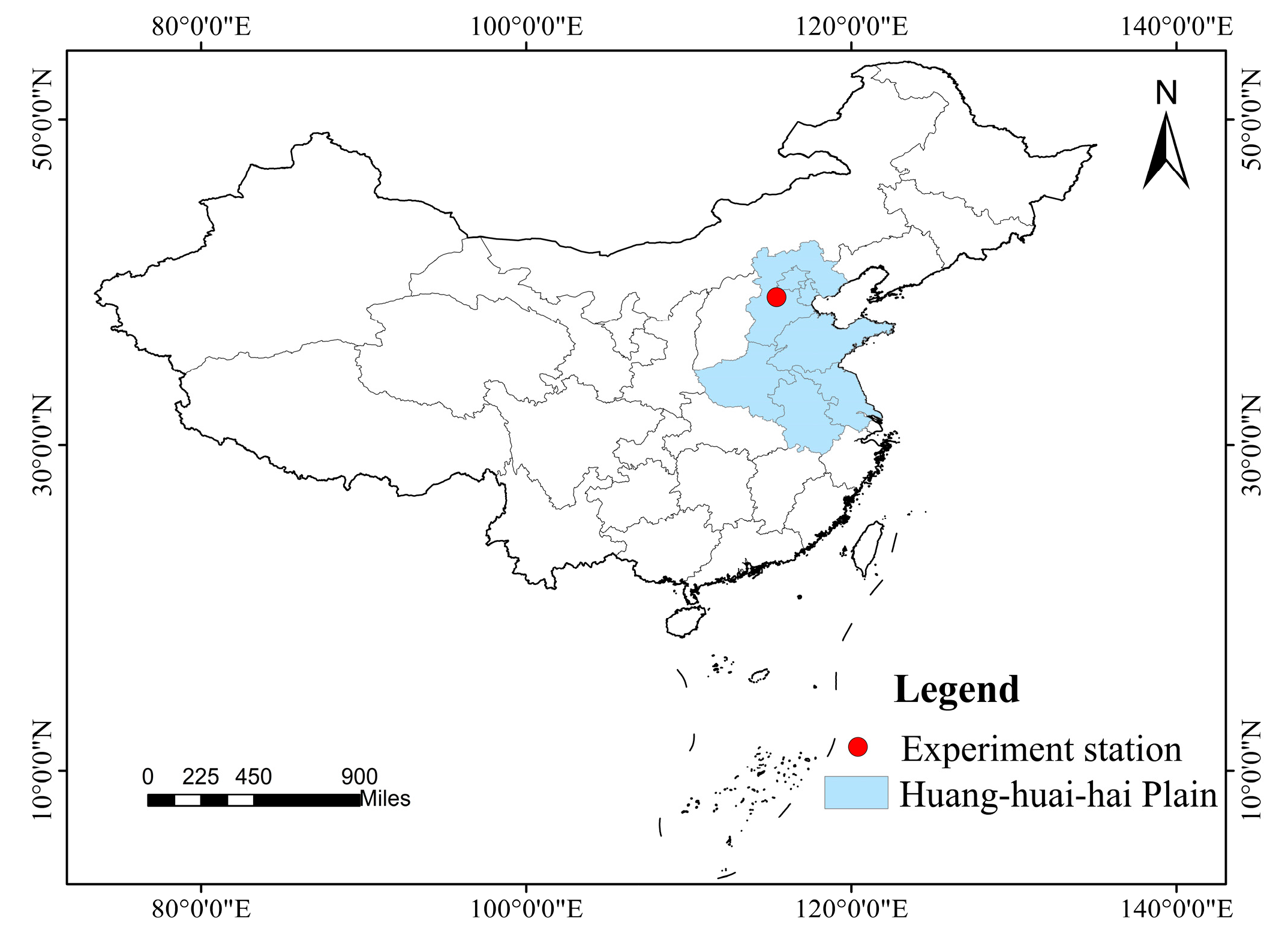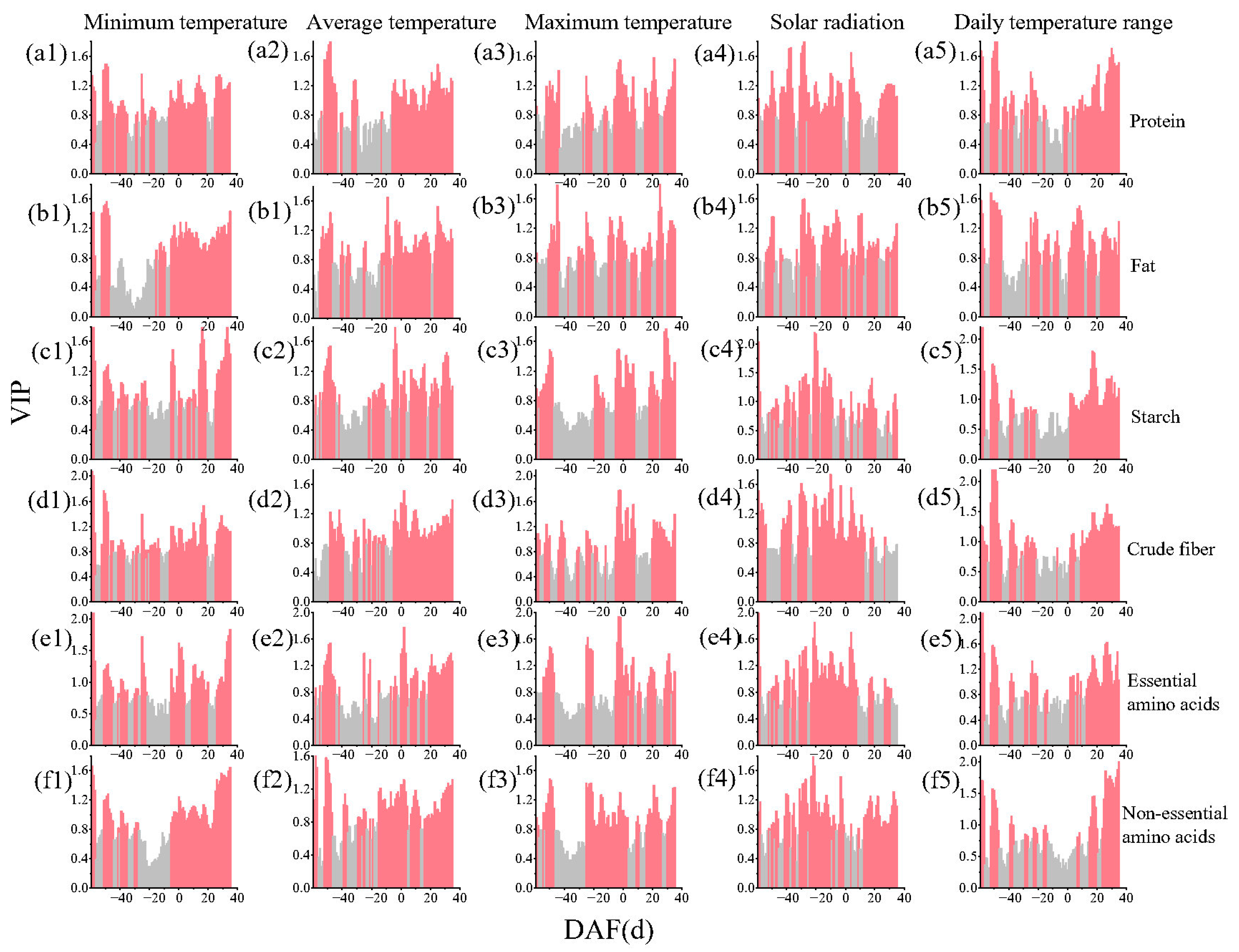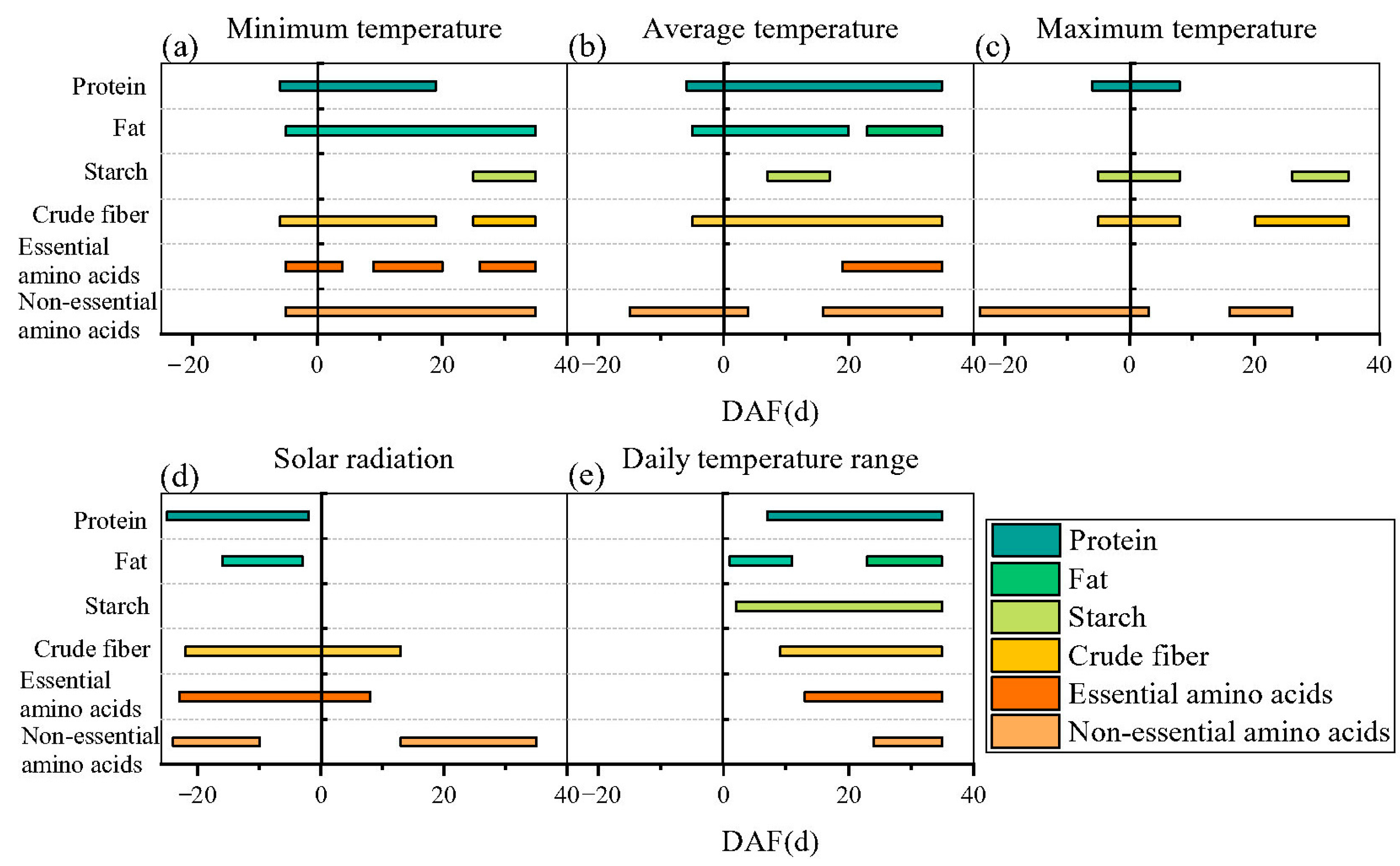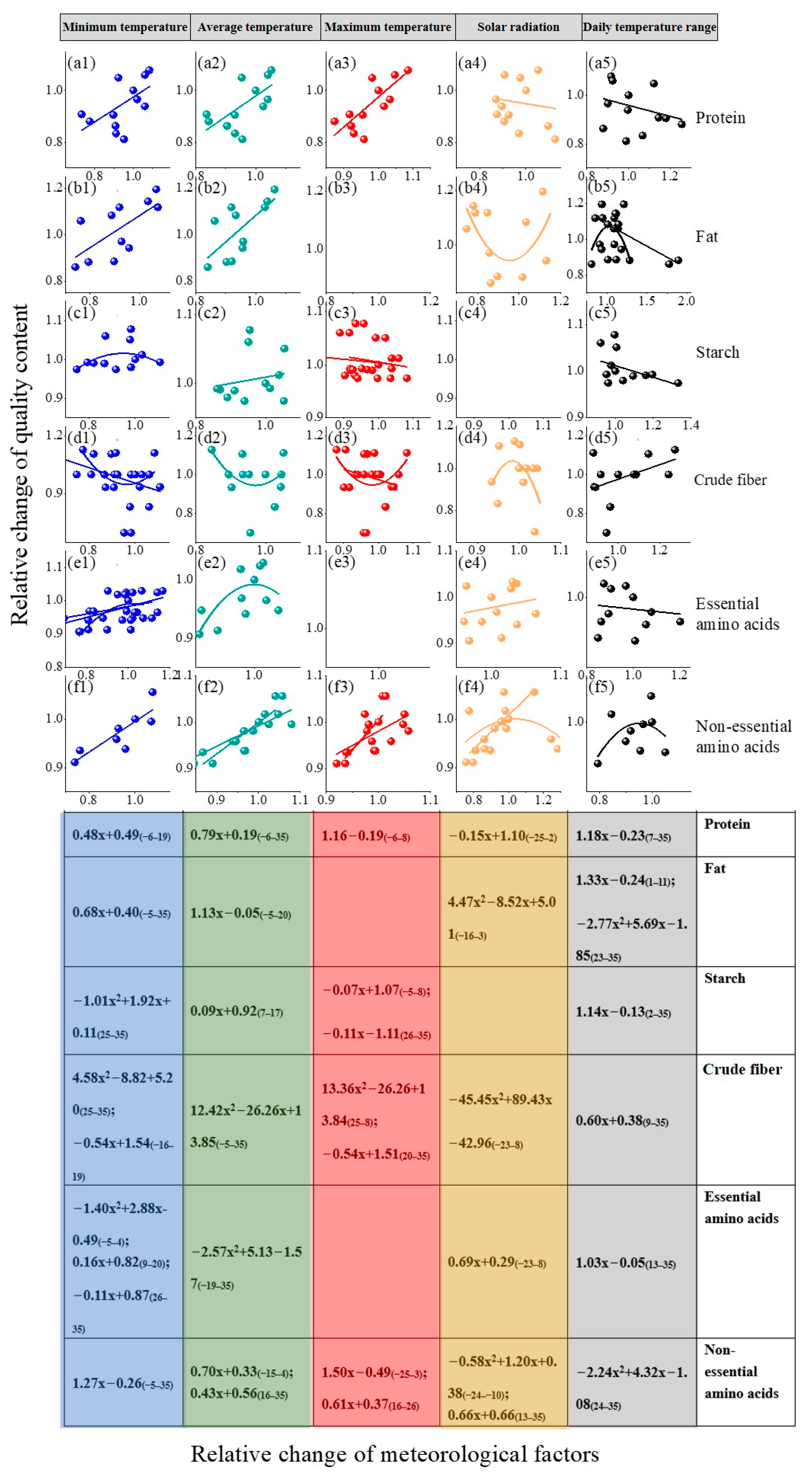Key Stage and Its Optimum Meteorological Conditions Affecting the Nutritional Quality of Maize
Abstract
1. Introduction
2. Materials and Methods
2.1. The Trial Design and Protocol
2.2. Data Sources
2.3. Data Analysis
2.3.1. Standardized Data
2.3.2. Partial Least-Squares Method
2.3.3. Coefficient of Variation
2.3.4. Evaluation Indexes
2.3.5. Data Statistics and Analysis
3. Results and Analysis
3.1. Nutritional Quality of Maize in Different Years and Sowing Dates
3.2. Key Stage and Meteorological Factors Affecting Nutritional Quality of Maize
3.3. Comprehensive Effects of Both Key Stage and Corresponding Meteorological Factors on Nutritional Quality
3.4. Optimization of Both Key Stage and Corresponding Meteorological Conditions Affecting Nutritional Quality of Maize
4. Discussion
4.1. Nutritional Quality of Maize Was Significantly Affected by Meteorological Conditions after Flowering
4.2. Temperature Is an Important Factor Affecting Grain Nutritional Qualities of Maize
4.3. Measures Improving Grain Nutritional Quality of Maize
5. Conclusions
Author Contributions
Funding
Data Availability Statement
Acknowledgments
Conflicts of Interest
References
- FAO. World Food and Agricultural 2022. Statistical Yearbook 2022. Available online: https://www.fao.org/faostat/zh/#home (accessed on 10 September 2023).
- Jahangirlou, M.R.; Akbari, G.A.; Alahdadi, I.; Soufizadeh, S.; Ludemann, C.; Parsons, D. Phenotypic predictors of dent maize grain quality based on different genetics and management practices. J. Cereal Sci. 2022, 103, 103388. [Google Scholar] [CrossRef]
- Lesk, C.; Rowhani, P.; Ramankutty, N. Influence of extreme weather disasters on global crop production. Nature 2016, 529, 7584. [Google Scholar] [CrossRef]
- Dhankher, O.P.; Foyer, C.H. Climate resilient crops for improving global food security and safety. Plant Cell Environ. 2018, 41, 877–884. [Google Scholar] [CrossRef]
- Varshney, R.K.; Bohra, A.; Roorkiwal, M.; Barmukh, R.; Cowling, W.; Chitikineni, A.; Lam, H.-M.; Hickey, L.T.; Croser, J.; Edwards, D.; et al. Rapid delivery systems for future food security. Nat. Biotechnol. 2021, 39, 1179–1181. [Google Scholar] [CrossRef]
- Farooq, M.S.; Uzair, M.; Raza, A.; Habib, M.; Xu, Y.; Yousuf, M.; Yang, S.H.; Khan, M.R. Uncovering the Research Gaps to Alleviate the Negative Impacts of Climate Change on Food Security: A Review. Front. Plant Sci. 2022, 13, 927535. [Google Scholar] [CrossRef]
- Chen, X.; Wang, L.; Niu, Z.; Zhang, M.; Li, C.; Li, J. The effects of projected climate change and extreme climate on maize and rice in the Yangtze River Basin, China. Agric. For. Meteorol. 2020, 282, 107867. [Google Scholar] [CrossRef]
- Zhao, Y.; Li, Z.; Hu, X.; Yang, G.; Wang, B.; Duan, D.; Fu, Y.; Liang, J.; Zhao, C. Spatial heterogeneity of county-level grain protein content in winter wheat in the Huang-Huai-Hai region of China. Eur. J. Agron. 2022, 134, 126466. [Google Scholar] [CrossRef]
- Kong, X.; Hou, R.; Yang, G.; Ouyang, Z. Climate warming extends the effective growth period of winter wheat and increases grain protein content. Agric. For. Meteorol. 2023, 336, 109477. [Google Scholar] [CrossRef]
- Kumar, S.; Bhushan, B.; Wakchaure, G.C.; Dutta, R.; Jat, B.S.; Meena, K.K.; Rakshit, S.; Pathak, H. Unveiling the impact of heat stress on seed biochemical composition of major cereal crops: Implications for crop resilience and nutritional value. Plant Stress 2023, 9, 100183. [Google Scholar] [CrossRef]
- Shi, K.; Gu, X.; Lu, W.; Lu, D. Effects of weak-light stress during grain filling on the physicochemical properties of normal maize starch. Cabohydrate Polym. 2018, 202, 47–55. [Google Scholar] [CrossRef]
- Jia, S.F.; Li, C.F.; Dong, S.T.; Zhang, J.W. Effects of Shading at Different Stages After Anthesis on Maize Grain Weight and Quality at Cytology Level. Agric. Sci. China 2011, 10, 58–69. [Google Scholar] [CrossRef]
- Yang, H.; Gu, X.; Ding, M.; Lu, W.; Lu, D. Heat stress during grain filling affects activities of enzymes involved in grain protein and starch synthesis in waxy maize. Sci. Rep. 2018, 8, 15665. [Google Scholar] [CrossRef]
- Yang, H.; Shen, X.; Lu, D.L.; Lu, W. Effects of heat stress durations at grain formation stage on grain yield and starch quality of waxy maize. Sci. Agric. Sin. 2017, 50, 2071–2082. (In Chinese) [Google Scholar]
- Butts-Wilmsmeyer, C.J.; Seebauer, J.R.; Singleton, L.; Below, F.E. Weather During Key Growth Stages Explains Grain Quality and Yield of Maize. Agronomy 2019, 9, 16. [Google Scholar] [CrossRef]
- National Bureau of Statistics of China. China Statistical Yearbook; China Statistic Press: Beijing, China, 2021. Available online: https://www.stats.gov.cn/sj/ndsj/2021/indexch.htm (accessed on 11 October 2023). (In Chinese)
- Liu, Z.M.; Li, L.; Li, H.; Liu, N.; Wang, H.X.; Shao, L.W. Changes and influencing factors of crop coefficient of summer maize during the past 40 years in the North China Plain. Chin. J. Eco-Agric. 2023, 31, 1355–1367. (In Chinese) [Google Scholar] [CrossRef]
- Zhou, H.; Zhou, G.; He, Q.; Zhou, L.; Ji, Y.; Lv, X. Capability of leaf water content and its threshold values in reflection of soil-plant water status in maize during prolonged drought. Ecol. Indic. 2021, 124, 107395. [Google Scholar] [CrossRef]
- Angstrom, A. Solar and terrestrial radiation. Report to the international commission for solar research on actinometric investigations of solar and atmospheric radiation. Q. J. R. Meteorol. Soc. 2010, 50, 121–126. [Google Scholar] [CrossRef]
- China Meteorological Administration. Specification for Agrometeorological Observation; China Meteorological Press: Beijing, China, 1993; Volume I. [Google Scholar]
- Wang, Z.; Chen, J.; Zhang, J.; Tan, X.; Raza, M.A.; Ma, J.; Zhu, Y.; Yang, F.; Yang, W. Assessing canopy nitrogen and carbon content in maize by canopy spectral reflectance and uninformative variable elimination. Crops J. 2022, 10, 1224–1238. [Google Scholar] [CrossRef]
- Guo, J.; Qu, L.; Wang, L.; Lu, W.; Lu, D. Effects of post-silking drought stress degree on grain yield and quality of waxy maize. J. Sci. Food Agric. 2023, 103, 1530–1540. [Google Scholar] [CrossRef]
- Cheikh, N.; Jones, R.J. Disruption of Maize Kernel Growth and Development by Heat Stress (Role of Cytokinin/Abscisic Acid Balance). Plant Physiol. 1994, 106, 45–51. [Google Scholar] [CrossRef]
- Jahangirlou, M.R.; Morel, J.; Akbari, G.A.; Alahdadi, I.; Soufizadeh, S.; Parsons, D. Combined use of APSIM and logistic regression models to predict the quality characteristics of maize grain. Eur. J. Agron. 2023, 142, 126629. [Google Scholar] [CrossRef]
- Ignacio Mayer, L.; Savin, R.; Angel Maddonni, G. Heat Stress during Grain Filling Modifies Kernel Protein Composition in Field-Grown Maize. Crops Sci. 2016, 56, 1890–1903. [Google Scholar] [CrossRef]
- Lu, D.; Shen, X.; Cai, X.; Yan, F.; Lu, W.; Shi, Y.-C. Effects of heat stress during grain filling on the structure and thermal properties of waxy maize starch. Food Chem. 2014, 143, 313–318. [Google Scholar] [CrossRef] [PubMed]
- Soares, J.C.; Santos, C.S.; Carvalho, S.M.P.; Pintado, M.M.; Vasconcelos, M.W. Preserving the nutritional quality of crop plants under a changing climate: Importance and strategies. Plant Soil 2019, 443, 1–26. [Google Scholar] [CrossRef]
- Bheemanahalli, R.; Vennam, R.R.; Ramamoorthy, P.; Reddy, K.R. Effects of Post-Flowering Heat and Drought Stresses on Physiology, Yield, and Quality in Maize (Zea mays L.). Plant Stress 2022, 6, 100106. [Google Scholar] [CrossRef]
- Canvin, D.T. The effect of temperature on the oil content and fatty acid composition of the oils from several oil seed crops. Can. J. Bot. 1965, 43, 63–69. [Google Scholar] [CrossRef]
- Singletary, G.W.; Banisadr, R.; Keeling, P.L. Heat Stress During Grain Filling in Maize: Effects on Carbohydrate Storage and Metabolism. Aust. J. Plant Physiol. 1994, 21, 829–841. [Google Scholar] [CrossRef]
- Gong, S.X. Food Crops and Weather; Beijing Agricultural University Press: Beijing, China, 1987; pp. 245–248. [Google Scholar]
- Zhou, L.Z.; Juranić, M.; Dresselhaus, T. Germiline development and fertilization mechanisms in maize. Mol. Plant. 2017, 10, 389–401. [Google Scholar] [CrossRef]
- Wang, Y.; Sheng, D.; Zhang, P.; Dong, X.; Yan, Y.; Hou, X.; Wang, P.; Huang, S. High temperature sensitivity of kernel formation in different short periods around silking in maize. Environ. Exp. Bot. 2020, 183, 104343. [Google Scholar] [CrossRef]
- Huang, M.; Zhang, H.; Zhao, C.; Chen, G.; Zou, Y. Amino acid content in rice grains is affected by high temperature during the early grain-filling period. Sci. Rep. 2019, 9, 2700. [Google Scholar] [CrossRef]
- Chen, M.; Li, Z.; Huang, J.; Yan, Y.; Wu, T.; Bian, M.; Zhou, J.; Wang, Y.; Lyv, Y.; Hu, G.; et al. Dissecting the meteorological and genetic factors affecting rice grain quality in Northeast Chian. Genes Genom. 2021, 43, 975–986. [Google Scholar] [CrossRef] [PubMed]
- Huang, Z.; Ming, B.; Hou, L.; Xue, J.; Wang, K.; Xie, R.; Hou, P.; Wang, Z.; Ma, D.; Gao, J.; et al. Improving maize quality from mechanical grain harvesting by matching maize varieties with accumulated temperature in northeast China. J. Sci. Food Agric. 2023, 103, 5061–5069. [Google Scholar] [CrossRef] [PubMed]
- Rizwan, M.; Zhu, Y.; Qing, P.; Zhang, D.; Ahmed, U.I.; Xu, H.; Iqbal, M.A.; Saboor, A.; Malik, A.M.; Nazir, A.; et al. Factors Determining Consumer Acceptance of Biofortified Food: Case of Zinc-Fortified Wheat in Pakistan’s Punjab Province. Front. Nutr. 2021, 8, 647823. [Google Scholar] [CrossRef] [PubMed]
- Caire-Juvera, G.; Vázquez-Ortiz, F.A.; Grijalva-Haro, M.I. Amino acid composition, score and in vitro protein digestibility of foods commonly consumed in northwest Mexico. Nutr. Hosp. 2013, 28, 365–371. [Google Scholar] [CrossRef]
- Wu, Y.; Messing, J. Proteome balancing of the maize seed for higher nutritional value. Front. Plant Sci. 2014, 5, 240. [Google Scholar] [CrossRef]
- Deng, F.; Zhang, C.; He, L.; Liao, S.; Li, Q.; Li, B.; Zhu, S.; Gao, Y.; Tao, Y.; Zhou, W.; et al. Delayed sowing date improves the quality of mechanically transplanted rice by optimizing temperature conditions during growth season. Field Crops Res. 2022, 281, 108493. [Google Scholar] [CrossRef]





| Year | Sowing Date | Protein (%) | Fat (%) | Starch (%) | Crude Fiber (%) |
|---|---|---|---|---|---|
| 2018 | S1 | 9.5 ab | 3.8 a | 68.4 a | 4.4 b |
| S2 | 9.9 a | 3.4 b | 68.9 a | 4.7 b | |
| S3 | 8.2 c | 3.8 a | 67.5 a | 4.7 b | |
| S4 | 8.7 bc | 3.6 ab | 70.4 a | 5.3 a | |
| 2019 | S1 | 8.0 a | 3.2 ab | 64.7 a | 2.0 a |
| S2 | 7.4 a | 3.4 a | 66.4 a | 1.8 b | |
| S3 | 7.8 a | 3.3 ab | 65.7 a | 1.8 b | |
| S4 | 7.9 a | 3.0 b | 64.7 a | 1.8 b | |
| 2020 | S1 | 8.5 a | 4.3 a | 66.0 a | 1.9 b |
| S2 | 8.0 ab | 3.6 b | 65.2 a | 1.9 b | |
| S3 | 7.2 b | 3.9 b | 64.6 a | 2.1 a | |
| S4 | 7.3 b | 3.1 c | 64.7 a | 1.8 b | |
| 2021 | S1 | 7.8 ab | 4 a | 66.1 a | 2.5 b |
| S2 | 8.31 a | 3.5 b | 62.9 a | 3 a | |
| S3 | 6.74 c | 3.3 bc | 67.8 a | 2.1 c | |
| S4 | 7.17 bc | 3.1 c | 66.7 a | 2.8 a | |
| 2022 | S1 | 7.94 a | 3.7 a | 60.9 a | 2.7 a |
| S2 | 7.17 b | 3.2 b | 60.2 a | 2.0 b | |
| S3 | 6.02 b | 3.0 b | 61.2 a | 2.2 b | |
| S4 | 6.81 c | 3.3 b | 62.5 a | 1.8 c | |
| Average | S1 | 8.35 | 3.79 | 65.22 | 2.70 |
| S2 | 8.15 | 3.41 | 64.72 | 2.68 | |
| S3 | 7.20 | 3.46 | 65.36 | 2.58 | |
| S4 | 7.57 | 3.21 | 65.80 | 2.70 | |
| CV (%) | 9.91 | 7.40 | 1.36 | 15.10 | |
| Sources of variation | S | ** | ** | \ | ** |
| Y | ** | ** | * | ** | |
| S × Y | ** | ** | \ | ** |
| Nutritional Quality | Minimum Temperature (°C) | Average Temperature (°C) | Maximum Temperature (°C) | Total Solar Radiation (MJ m−2) | Daily Temperature Range (°C) | Constant Term | R2 |
|---|---|---|---|---|---|---|---|
| Protein | / | / | 0.28 (−6–8 d) | / | / | −1.11 | 0.60 |
| Fat | −0.26 (−5– 35 d) | 0.37 (−5–20 d) | / | −0.0000046 (2) (−16–−3 d) | −0.001 (1–11 d); −0.069 (2) (23–35 d) | 0.495 | 0.76 |
| Starch | / | / | / | / | / | / | / |
| Crude fiber | −0.025 (2) (23–35 d) | 0.031 (2) (−5–35 d); | −0.015 (2) (−5–8 d) | −0.0000087 (2) (−22–13 d); | −0.31 (9–35 d) | 14.40 | 0.67 |
| Essential amino acids | 0.03 (2) (−5–4 d); 0.33 (9–20 d); 0.22 (26–35 d) | −0.05 (19–35 d) | / | −0.08 (−23–8 d) | −0.32 (13–35 d) | 67.73 | 0.72 |
| Non-essential amino acids | −1.46 (−5–35 d) | 10.96 (−15–4 d); −6.89 (16–35 d) | −1.53 (−25–3 d); 2.46 (16–26 d) | −0.000029 (2) (13–35 d) | 0.44 (24–35 d) | −97.54 | 0.89 |
| Nutritional Quality | N | Mean Simulated Value (%) | Mean Measured Value (%) | P(t*) | α | β | R2 | RMSE | nRMSE (%) |
|---|---|---|---|---|---|---|---|---|---|
| Protein | 4 | 7.26 | 6.99 | 0.31 | 0.91 | 0.41 | 0.58 | 0.53 | 7.53 |
| Fat | 4 | 3.09 | 3.29 | 0.19 | 0.87 | 0.61 | 0.88 | 0.22 | 6.57 |
| Crude fiber | 4 | 2.25 | 2.21 | 0.38 | 0.44 | 1.21 | 0.47 | 0.38 | 17.07 |
| Essential amino acids | 4 | 27.43 | 24.76 | 0.12 | 0.69 | 12.60 | 0.58 | 2.11 | 5.30 |
| Non-essential amino acids | 4 | 39.04 | 39.72 | 0.39 | 1.81 | −24.85 | 0.61 | 3.47 | 14.00 |
| Nutritional Quality | Minimum Temperature (°C) | Average Temperature (°C) | Maximum Temperature (°C) | Total Solar Radiation (MJ m−2) | Temperature Daily Range (°C) | Constrained Value | Optimization Value |
|---|---|---|---|---|---|---|---|
| Protein | / | / | 31.2 | / | / | 6.74 | 9.66 |
| Fat | 12.0 | 24.9 | / | 627.01 | 8.9 | 3.00 | 4.80 |
| Starch | / | / | / | / | / | / | / |
| Crude fiber | 12.0 | 22.4 | 27.1 | 627.01 | 8.9 | 1.80 | 4.97 |
| Essential amino acids | 18.9 | 24.9 | / | 627.01 | 8.9 | 19.99 | 40.39 |
| Non-essential amino acids | 12.0 | 24.9 | 31.2 | 627.01 | 15.0 | 30.61 | 58.96 |
| Min | 12.0 | 18.4 | 25.9 | 627.01 | 8.9 | / | / |
| Max | 20.5 | 24.9 | 31.2 | 916.00 | 15.0 | / | / |
Disclaimer/Publisher’s Note: The statements, opinions and data contained in all publications are solely those of the individual author(s) and contributor(s) and not of MDPI and/or the editor(s). MDPI and/or the editor(s) disclaim responsibility for any injury to people or property resulting from any ideas, methods, instructions or products referred to in the content. |
© 2024 by the authors. Licensee MDPI, Basel, Switzerland. This article is an open access article distributed under the terms and conditions of the Creative Commons Attribution (CC BY) license (https://creativecommons.org/licenses/by/4.0/).
Share and Cite
Wu, Y.; Zhou, G.; Song, X.; Song, Y.; Ren, S.; Geng, J.; Zhao, H. Key Stage and Its Optimum Meteorological Conditions Affecting the Nutritional Quality of Maize. Agronomy 2024, 14, 420. https://doi.org/10.3390/agronomy14030420
Wu Y, Zhou G, Song X, Song Y, Ren S, Geng J, Zhao H. Key Stage and Its Optimum Meteorological Conditions Affecting the Nutritional Quality of Maize. Agronomy. 2024; 14(3):420. https://doi.org/10.3390/agronomy14030420
Chicago/Turabian StyleWu, Yixuan, Guangsheng Zhou, Xingyang Song, Yanling Song, Sanxue Ren, Jinjian Geng, and Huarong Zhao. 2024. "Key Stage and Its Optimum Meteorological Conditions Affecting the Nutritional Quality of Maize" Agronomy 14, no. 3: 420. https://doi.org/10.3390/agronomy14030420
APA StyleWu, Y., Zhou, G., Song, X., Song, Y., Ren, S., Geng, J., & Zhao, H. (2024). Key Stage and Its Optimum Meteorological Conditions Affecting the Nutritional Quality of Maize. Agronomy, 14(3), 420. https://doi.org/10.3390/agronomy14030420







